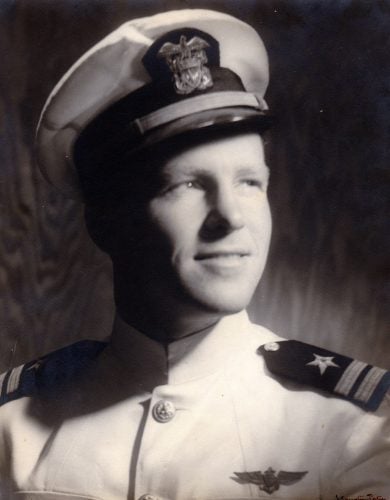- Lieutenant, USN
- WW II
Biography
Stuart Trumble Cooper was born in Plainfield, Connecticut on 20 August 1917. His family later moved to Narragansett, Rhode Island. He was the youngest of three children of Representative and Mrs. Ulysses Grant Cooper, member of the Rhode Island House of Representatives from Narragansett, Rhode Island. Stuart was a 1935 graduate of South Kingstown, Rhode Island High School where he was an outstanding student and athlete. He entered Rhode Island State College (RISC) in September 1935 with the class of 1939. He was a member of Beta Phi Fraternity, an outstanding member of the Football and Track teams, member of the Rhode Island Club and Rhode Island State Players. Stuart also participated in the Army ROTC program for two years. Stuart graduated from RISC with a Bachelor of Science Degree in Physical Education in June 1939.
Stuart enlisted in the U.S. Navy on 19 September 1939. He attended air cadet training at Floyd Bennet Field, New York, aviation training at Naval Air Station, Pensacola, Florida, and the advanced aviation training at Corpus Christi Naval Air Station, Texas. He was commissioned an Ensign, U.S. Navy Reserve on 4 June 1939. Lt. Cooper and Phyllis Mae Priest were married in November 1942, three months before his death.
Lieutenant Cooper was assigned to the US Navy Patrol Squadron, Pacific Theater. On 6 June 1942, Lt. Cooper was the pilot of a PB4Y-1 Liberator where he performed the rescue of the crew of a US Army Air Force B-24 from the 72nd Bomb Squadron after it was shot down. On 14 February 1943, LT Cooper was the pilot of one of eight US Navy PB4Y-1 aircrafts that bombed and sank an enemy destroyer and transport from 22,000 feet altitude off the coast of South Bougainville in the Pacific Ocean. Soon over 50 enemy fighters from Kahili Airfield came to intercept the US Navy planes. Lt. Cooper and his crew shot down nine enemy fighters before his plane was shot down, and the entire crew was declared Missing in Action. The dogfight was known as “The Valentine’s Day Massacre,” as many aircraft on both sides were destroyed.
On 26 November 1948, Lieutenant Stuart Trumble Cooper, U.S. Navy Reserve, was cited for bravery in the vicinity of Midway and awarded the Distinguished Flying Cross, Air Medal and Purple Heart (Posthumously).
Distinguished Flying Cross Citation
The President of the United States of America takes pride in presenting the Distinguished Flying Cross (Posthumously) to Lieutenant Stuart Trumble Cooper , United States Navy Reserve, for heroism and extraordinary achievement in aerial flight as pilot of a Liberator Plane in Patrol Squadron FIFTY ONE, later designated as Bombing Squadron ONE HUNDRED ONE, in action against enemy Japanese forces in the vicinity of Midway from June 1 to 9, 1942; and in the South Pacific War Area from January 27, to February 14, 1943. Participating in numerous missions in the face of hostile antiaircraft fire, Lieutenant Cooper contributed materially to the success of his squadron. During a hazardous engagement over Bougainville on February 14, he assisted in scoring hits on two large enemy ships and in destroying nine hostile aircraft before his plane received fatal damage. His cool courage and unwavering devotion to duty reflect the highest credit upon Lieutenant Cooper and the United States Naval Service.
Lieutenant Stuart Trumble Cooper, U.S. Navy Reserve, answered the call to serve in World War II and gallantly gave his life in service to our country. He is a heroic member of the “Greatest Generation.”
Education
1939

